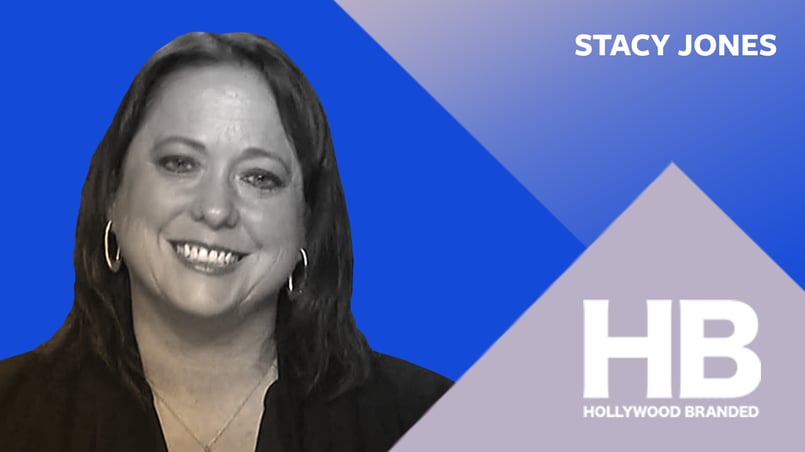Our guest Stacy Jones delves into how film production and brand marketing work hand-in-hand to bring some of your favorite consumer brands to the big screen.
The following interview is an excerpt from our video series, Production - In Conversation. To watch the full interview and see more video content, click here. Or you can listen to the Shift In Conversation podcast here.
------
Stacy Jones - CEO - Hollywood Branded
Grace Amodeo - Marketing Manager - Shift Media
Grace:
I'd love to start off by introducing yourself. Tell us about your company and what you do.
Stacy:
I founded Hollywood Branded back in 2007 and we are a pop culture content marketing agency. What that means is we leverage Hollywood, celebrities, and influencers in order to have them become part of a brand's marketing campaign or have the brand become part of their content. We work on TV shows, feature films, and music videos and we create product placement opportunities for the brand to be interwoven in the storyline to be used as a prop, a set or location, or a wardrobe item.
Grace:
Can you walk us through a typical workflow for your company? Let’s say a brand comes to you or a production comes to you, how do you work through that process with each of your clients?
Stacy:
So we're positioned as the brain in between a production and a brand. We have a really stellar reputation in Hollywood, so all the studios and production companies come to us. They provide their scripts to us and our team goes in, we read them, we break them down, and we look for the opportunities for brands to become part of that essence of the script. So there's three tiers of involvement there. The first is trade and loan. When we're working with the brand, they're getting actually cast, just like talent, into that content. A brand has its own story and they have their own type of consumer that uses that product, and it helps immediately cement who that character on screen is. But production can't just go to the grocery store, buy lots of products, and shove them in the scene, they actually need to get clearances. So all of this helps the production save time and money, and then they're able to work on creating their content better with the dollars that they have.
When we're working with the brand, they're getting actually cast, just like talent, into that content.
On the second level, we have cash. Only about 40% of Hollywood even takes dollar deals for integration, most of the time the partnerships you're seeing are based on a trade out or a loan of goods. The third way brands help movies come to life is through promotional partnerships. If a film is able to work with a brand, the brand may say, “Okay, for 6-8 weeks around this movie’s release, we’re going to co-brand our TV, digital, out-of-home, print advertising, and in-store retail”. They allow their advertising to be taken over and they're co-promoting it.
Grace:
So it's really a win-win situation for both the brand and the production. How do you make sure that you're addressing and speaking to the needs of both parties?
Stacy:
Our goal at the end of the day is not to be shoving a brand down a viewer's throat. That's not the brand's goal, and that's certainly not the production's goal either. Productions are creative souls. They actually don't love being told what they need to do and how they need to have their content shaped. We speak the language of productions, so we can take a deep dive and look at a production and see where a brand may actually help, where they can offset those dollars, and also where they can make a scene more real. On the opposite side with the brand, brands are notorious for wanting to control their messaging. You can't do that in a movie or a TV show. We work with the brand to help them understand how we need to sculpt and craft, where messaging makes sense and where it's a little obnoxious.
Brands are notorious for wanting to control their messaging. You can't do that in a movie or a TV show.
Grace:
Do you find when you work that the first contact often comes from one side or the other? Do either brands or productions tend to start the conversation with you first?
Stacy:
Well, pre-COVID we were working on a minimum of 6 to 15 new productions on a weekly basis. So we were getting new productions every single day. But we also get our clients who are brands that are hiring us to look for opportunities for them, so there are other productions out there that we're hunting down. We have stalkers on our team, we have lurkers on our team. They know how to go through social media accounts, they know how to find the people on set who are the decision-makers and who can then engage with to talk about these other brands who they might not have ever thought of.
Grace:
You're like a brand matchmaker! With production currently at a standstill, can you talk me through what your job looks like now? Are you finding a way to pivot your strategy so you can continue to get brands in front of audiences?
We've moved over our product placement clients in almost every instance to doing influencer marketing, and that is surging.
Stacy:
We've moved over our product placement clients in almost every instance to doing influencer marketing, and that is surging. Because so much marketing activity has stopped, it's really easy for brands to silo in to see what is working. If we're the only ones doing anything right now, then it's working and you're able to see the results from that. All productions have not ground to a halt, we have evening talk shows -- Kimmel, Fallon, Colbert -- that are back, and daytime talk shows that are still filming, albeit remotely. HGTV is in the midst of shooting home makeover shows remotely. So there are content options that brands can get involved in right this minute.
Grace:
So as a user or as a viewer, where can I expect to be seeing those brand placements? If we're not seeing them in movies and television shows, where are we going to start seeing them more?
Stacy:
Well, we're definitely seeing them right now on your evening and your daytime talk shows, those are 100% popping up. You're also going to see more celebrities and more influencers doing influencer posts and supporting brand collaborations that are digitally driven. It's not that difficult to send out a halo light and a microphone and some cameras. We've been working with different production companies that are really finessing their skills and they're offering branded content partnerships right now that can be built. The networks are hungry for opportunities because there is a deficit of content that's going to be coming up.
Grace:
Are you seeing different types of brands increase their presence and, conversely, other types of brands decreasing their presence?
Stacy:
We're seeing a massive freeze on brand spend. A lot of the deals that were on the table, they got ended because the production is not moving forward. And a lot of the deals that were in discussion for later, brands are scared because they don't know what's happening. But there are phases to this, there is a light at the end of the tunnel. We’re entering into phase two at the moment where that light is showing us that people are going to stop lock-ins, other countries are coming out of this, there are plans. Life is going to have to eventually return to a new normal, not the same normal but a new normal. We need product still. So all of these different industries are figuring it out, you have your food industries right now in overdrive. Industries that are healthcare-related, those are all making money right now. A lot of digital platforms, apps, and software solutions are extremely interested in opportunities right now because they are still seeing the need for digital marketing.
Grace:
Internally, how have you changed your own marketing strategy to make sure that you're still getting in front of your customers?
Stacy:
So our agency is very, very inbound based. We use HubSpot in order to manage our blogs, we have over 30,000 people who read our content on a monthly basis. We have a great subscription e-newsletter that goes out. We have a podcast, "Marketing Mistakes and How to Avoid Them" that I host where I speak with people in brands and agencies on how to do marketing and business better. All of those have been really strong components of what we do. The first week of August, we're launching the Marketers Content Playbook Virtual Summit, where we're bringing in potentially over a hundred speakers to provide insights to brands and agencies on how to do content marketing better. So what we've done is taken this time to dial back and figure out what people need, what people are interested in. Our solution is to create something that's inbound-based, something that serves, that offers and educates and gives back.
--------
Would you like to participate in a future In Conversation video interview? Email grace@shift.io for more information.






